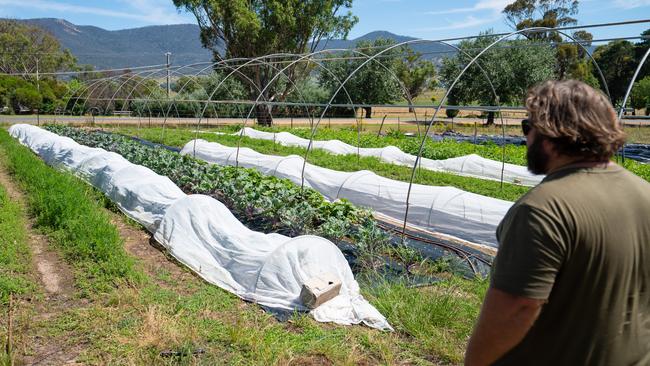Bushfire recovery: Corryong Acres and Acres market garden secures food supply
After living through bushfire and Covid, Corryong locals could see a food security crisis looming, so decided to grow their own.
One tiny patch of green was all that was left of Josh Collings’ Cudgewa property after the 2019-20 bushfires scorched his Alpine community and burnt his house to the ground.
“My vegie garden kind of survived, even though every centimetre of everything else was burnt out,” said Josh, 40, who took inspiration from the defiant plants.
Josh has been heavily involved in fire-recovery efforts in Corryong, and last March started a co-operative market garden called Acres and Acres, where locals could produce vegetables to provide food for their communities and earn an income.
He hatched the plan with gardeners from his vegie-swap group, who wanted to maintain food security for the isolated region, and make it easy for people to start farming with little financial outlay.
“Everyone was eating dry food at the time; there is no real fresh food in the area,” Josh said.
The food supply chain was strained during the disaster period, and Covid made it worse.
“We started talking about the fact we’re at the end of the (supply chain) line,” Josh said. “We already get the seconds when it comes to quality of food, as most regional towns do.
“Everyone was taking toilet paper, we knew sooner or later they would start to realise food is more important that wiping your bum.”

On a mission to make sure the town could feed itself, Josh ramped up the scale of Acres and Acres over the past 18 months.
It now includes three garden sites, each about 0.4ha – or one acre – in size. The co-op grows everything from capsicum and tomatoes to melons and pumpkins. “It’s 20 cultivars all together,” Josh said. “And 10 would be a better number. Creating diversity was our goal to start.”
The produce is sold directly to the community, local shops and restaurants. A commercial garlic crop on a fourth site is planned for next year. Grants have funded much of the project, including a tool library and farm kitchen, with experienced growers from outside the region providing advice and infrastructure.
“It was about how do we create not just a community garden, but a bigger-scale version of a community garden, which is a market garden. Then it kept snowballing,” Josh said.
Josh is a finalist in the Community Legend category of the 2021 Victorian Health Promotion Awards, which acknowledge extraordinary people, groups and projects that have made a difference to communities across Victoria over the past two years.
Acres and Acres is just one example of successful community-led recovery efforts in bushfire-hit towns.

However, there is still a lot of work to do.
State-wide, the fires killed five people, destroyed 313 homes and scorched 1.49 million hectares across the North East and East Gippsland.
In Towong Shire 82 dwellings were destroyed, including Josh’s home.
“My house still isn’t built,” Josh said. “That is pretty distressing. There are lots of people whose houses aren’t built; they are not even close.”
In Mallacoota, where 130 homes were destroyed, the story is the same.
Mallacoota and District Recovery Association chair Paul Preston said just 13 or 14 homes had received final inspection certificates over the past two years.
The Covid-induced building boom, and shortage of workers and materials, had pushed the problem to crisis point, he said.
“Probably the biggest bottleneck is actually getting people to build,” he said. “It is just a perfect storm.”

Holiday accommodation had generously been made available to people displaced by the fires, but properties owners were slowly wanting to return to the seasonal rental market. And small dwellings were being replaced by more expensive, larger houses that would not meet the needs of some renters, Paul said.
“We can see good people are really in housing stress,” Paul said. “(Government agencies) talk about short, medium and long-term plans. We said, ‘nope, we can’t do that’.
“We threw ‘immediate’ in there. There are people now sleeping on couches. We can see it in Mallacoota.”
He said the community had received great support from all levels of government, and much progress had been made replacing infrastructure such as sports clubs and halls.
Social housing was now top of the agenda for the MADRA committee, which hoped a solution could be achieved in 2022.
In Corryong, Josh and others are also eager for housing works to gain pace.
As they wait, they have plenty of other challenges to deal with. Managing crops, maintaining soil health and keeping pests at bay is no small feat, they have learnt.
“You deal with every problem. This is no walk in the park,” Josh said. “It has been very challenging on many levels, but also fantastic.”




